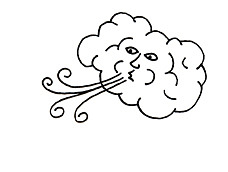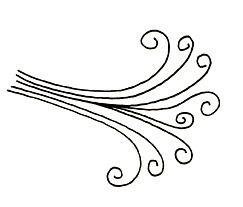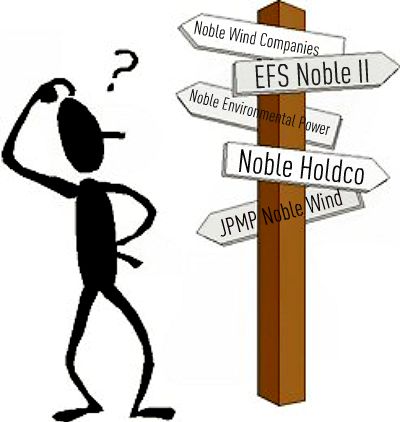Wind company employee gets Wind Turbine Syndrome (Altona, NY)
Mar 19, 2009
—by Calvin Luther Martin, PhD
When Noble Environmental Power of Essex, Conn., came to the North Country [of New York State] to investigate the possibility of establishing wind farms in northern Clinton and Franklin counties, officials of the company assured us that, while of course aiming to capitalize on the enthusiasm over green wind power, they also wanted to be honest and straightforward with residents.
They wanted to befriend the people living here and assure them wind energy was safe, clean and inexpensive. It would be a welcome replacement, little by little, for foreign oil on which the world perilously relied. They hoped for a long, happy relationship with people who embraced wind power and even those who didn’t. (Emphasis added.)
My friend Bob Grady, Editor-in-Chief of the Plattsburgh Press Republican, wrote those words. Bob wrote them in an editorial published March 12, 2009, in response to Noble’s “disappoint[ing] response to the first calamity here of the wind-farm era”: the spectacular disintegration and burning of Noble’s turbine in Altona, NY. (Click here for aerial photos and here for video.)
He titled it, “Noble response far from noble.” Indeed.
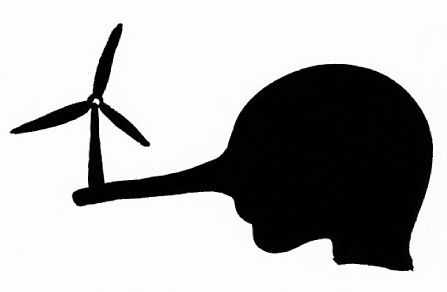
From plataformahorta.org, with appreciation
My dear Bob, allow me to correct you. The crashing and burning of Noble’s turbine was not its first calamity. I invite you to send a reporter to visit a woman named Cheryl LeClair, 349 Duley Road, Altona. On second thought, better go yourself. (Denise Raymo’s pious balderdash on Noble is nearly as hopeless as the Shelly Livernois’s in the Telegram).
Cheryl describes an experience equally calamitous to the turbine disaster. Although I’m not at liberty to reprint Cheryl’s letter, I shall paraphrase parts and quote other passages, according to the Fair Use principle in publishing and journalism. Note that her email was sent to my wife, Dr. Nina Pierpont, along with State Assemblywoman Janet Duprey and Altona Town Supervisor Larry Ross, bearing the plea, “I am appealing for any help that you can give to me.”
Bringing this sordid matter to public attention is the best help I can think of.
I have several reasons for discussing Cheryl’s letter. One is directed to the Franklin County District Attorney, Derek Champagne, who is a member of the New York State task force charged with monitoring and enforcing wind company ethics. I think, Bob, that between your unease with Noble and its spectacular equipment failure and subsequent rhetorical cover-up and obfuscation, and between my unease over Cheryl’s plight, below, it would behoove Derek Champagne to convene his committee and summon Noble brass to a meeting where tough questions are asked, and real answers demanded. Not platitude, not warmed over advertising copy, not blah blah blah—but God-honest truth.
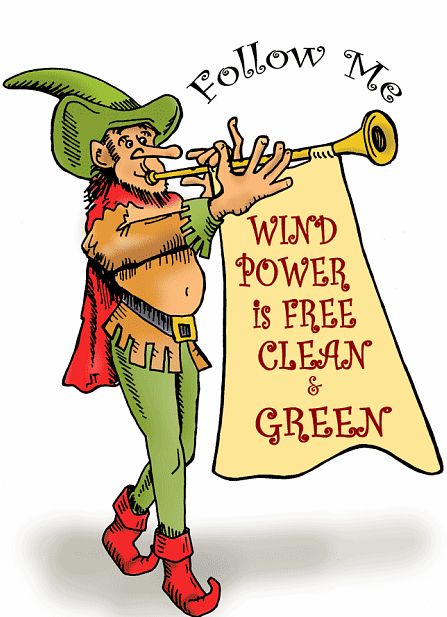
With thanks to Windtoons.com
You end your editorial, Bob, urging Noble “to adopt a policy of candor with the public.” I couldn’t agree more. “Were the naysayers right after all,” you ask? (I was one of them.) “They warned of bird kill, noise and maddening flicker from the revolution of the blades, but nobody talked about the 400-foot-high towers actually breaking and falling to the ground.”
Um, Bob, maybe you weren’t listening real carefully as you and the Press were whooping it up for wind energy—but we did in fact talk about (and present documentation of) these huge structures falling over, and we talked about fires.1 (To refer to those who did their homework and recognized these hazards four years ago, as “naysayers,” is an epithet akin to referring to you and your news staff as “wind shills.” A cheap shot which avoids the hard questions. Wouldn’t you agree?)
But I digress. Cheryl LeClair is a hardworking woman who, as I say, lives in Altona. Some years back she bought her dream home. (“I have lived here for ten years, enjoying the serenity, the view, the peacefulness.”) She is an avid oudoorsperson, as she takes pains to describe in her letter. Loves nature, loves being outside, loves gardening and feeding the birds and working in her yard. Even washing her truck—because it means she’s outside.
Except that her ecstasy is in the past tense, now that her home and property are menaced by Noble’s turbines. (“Menaced”? You will see in a moment why I choose this word.)
Before going further, realize that Cheryl was a Noble employee. This makes her story doubly interesting—both to the rest of us and, especially, to Cheryl herself. She’s flabbergasted at the shabby way Noble treated her complaints. (In fairness to Cheryl and Noble, she does acknowledge that Noble was a good employer.)
So, what happened to Ms. LeClair? Noble built its turbines, turned ’em on—and Cheryl’s quality of life crashed and burned. Here are excerpts from her letter. This first passage was written to Dr. Pierpont, Assemblywoman Duprey, and Town Supervisor Ross on 2/12/09.
The visual effects of the windpark are very disorienting. I can see turbines from all but one window. They give me a feeling of motion sickness and dizziness. The sound on a breezy day like today is maddening. I have been told that I am in a unique position in which the sound reverberates/echoes/concentrates on/to my home. I am constantly expecting to see an airplane overhead. At night the flashing lights have four or five tempos/patterns between all that I can see and that are currently running, not in sync. (Emphasis added.)
I direct your attention to the line, “I have been told I am in a unique position in which sound reverberates/echoes/concentrates on my home.” Wind energy companies always tell Wind Turbine Syndrome sufferers this. Visit Dr. Pierpont’s website (click here) on Wind Turbine Syndrome, and start reading what’s turning into an endless parade of people around the world experiencing exactly what Cheryl describes. (Find these account under Diaries and Reports.)
Is Cheryl’s experience unique? Of course not. Wind developers use this argument to avoid responsibility and accountability. It’s time—Derek, are you reading this?—that this charade and farce gets stopped by the government. There are too many Cheryl LeClairs getting hurt.
Consider this passage written by a man in Fond du Lac County, Wisconsin—a man likewise suffering from Wind Turbine Syndrome. His name is Gerry Meyer. He’s a retired postal carrier. The salt of the earth is Gerry. (He refers to himself as “just an average person.”) I have come to know Gerry because he has appealed to Dr. Pierpont for help, if only in understanding his family’s new, turbine-generated health problems.
March 3, 2008, the turbines began turning. When I walked out of the house and looked for a jet in the sky that in reality was the turbine 1560′ north of our house, I was ticked. I decided to keep a diary.
I have complained to the town board one time, and a friend has complained directly to Invenergy (the energy company) 8 to 10 times, and many others have complained to the town, Invenergy, or the county health departments. At meetings, energy companies will recite that Fond du Lac and Dodge County health departments have received no complaints about health effects from the wind turbines (I live in Fond du Lac County), and when the USA Today story about us appeared on November 4th, 2008, a woman spokesman for Invenergy told the reporter they have received no complaints.
It appears, unfortunately, that the only way they will consider a complaint [to be] a [genuine] complaint is if there is a lawsuit.
It is so sad that today with all the protections enacted and all of the concerns about people’s rights (at least some people), that … the reckless placement of wind turbines all over the country can take place. (Emphasis added.)
Where’s the candor from Invenergy about these health complaints? Reading Gerry’s letter, you get the distinct impression that Invenergy considers him and his suffering neighbors invisible—which is right up there with Cheryl LeClair being told she’s “unique.” As in, Gee, nobody else complains about health effects and disrupted TV reception, Cheryl! You’re really unique!
“Unique,” here, has the connotation “you’re a nut case.”
As I say, Bob, read through those endless Diaries and Reports on the WTS.com site. Lots of unique nut cases, right?
Back to Cheryl. By early January 2009 she realized something was horribly wrong. Cheryl was still on Noble’s payroll (through January). On 1/14/09 she wrote a desperate letter to Lisa Vigneault, with copies of Dan Nugent and Brett Hastings—all of these being Noble employees. She prefaced her letter by saying “I need to voice my frustration, concern, disappointment and anger, and hope for some relief.”
The letter goes on to list her complaints:
(1) Television reception messed up. (“One night last week, the interference was ‘keeping time’ to the turning of the turbine.”)
(2) The flashing red lights. She calls them “horrendous.” “They leave ‘trails’ when you look away, as well.”
(3) The “whoosh whoosh” noise of the turbines within her home. “It is not anything like the steady hum of a refrigerator,” she points out. This being a sarcastic jab at Noble’s advertising. (See “People who state that wind turbines are very quiet are probably good candidates for a lobotomy,” by Wisconsin homeowner, Larry Wunsch.) Open Noble’s website, click through to its propaganda about the glories of wind energy, and open Wind Fact Sheet #5: Are modern wind turbines noisy? Start reading:
Are modern wind turbines noisy? No. It’s true that some older turbines designs were noisy. However, the wind turbine manufacturers have worked hard to improve turbine design. Modern wind turbines are much more efficient and make much less sound … nowadays, they are actually pretty quiet. A commonly used reference is that at a distance of 750 to 1,000 feet a modern wind turbine is no noisier than a kitchen refrigerator or a moderately quiet room (American Wind Energy Association). While proper “setbacks” from homes are still essential, at 1,000 feet, the sound of a modern turbine is practically indiscernible over the background noise associated with the environment in which a turbine is placed. Very often, one of the loudest background noises is the wind itself!
So, one more time … are wind turbines noisy? We often use the word “noise” to refer to “any unwanted sound.” It’s true that wind turbines make sounds … but whether or not those sounds are “noisy” has a lot to do with who’s listening. It’s also worth noting that studies have shown that a person’s attitude toward a sound—meaning whether it’s a “wanted” or “unwanted” sound—depends a great deal on what they think and how they feel about the source of the sound. In other words, if someone has a negative attitude to wind turbines, or is worried about them, this will affect how they feel about the sound. However, if someone has a positive attitude toward wind energy, it’s very unlikely that the sounds will bother them at all. (Emphasis added.)
—from Noble Environmental Power, “Wind fact sheet #5: Are modern wind turbines noisy?”
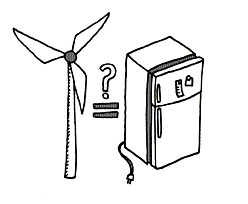
R. Forrest Martin, with appreciation
A clarification. The “studies” Noble refers to appear to be nothing more than speculation by noise engineers, who, by the way, have zero clinical training. (See the pronouncements of a physicist/acoustician who has done consulting work for Noble, Dr. Geoff Leventhall.) Dr. Pierpont, a physician, has used published clinical studies to demonstrate that people’s aversive reactions to wind turbine noise are the result of disturbance to the organs of balance, and motion and position sense, within the inner ear.
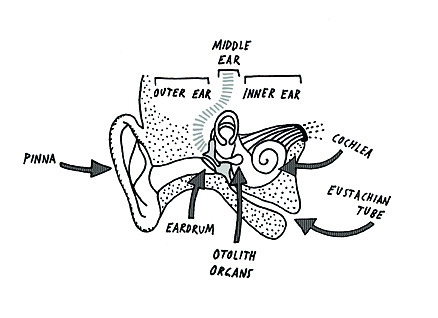
R. Forrest Martin, with appreciation
Low frequency noise from wind turbines sends false signals to these highly sensitive structures (utricle and saccule, and semicircular canals), causing dizziness, vertigo, and nausea, along with cognitive and memory deficits, and anxiety and panic attacks. Pierpont shows that these symptoms are not under voluntary, conscious control; they are completely involuntary—as involuntary as puking when you get motion sickness (carsick or seasick). Indeed, she demonstrates that Wind Turbine Syndrome basically operates by triggering chronic motion sickness. (WTS is a constellation of symptoms, including sleeplessness, and involves several sensory systems besides the inner ear being dis-regulated. Even so, the inner ear structures are vital to understanding the pathophysiology of Wind Turbine Syndrome.)
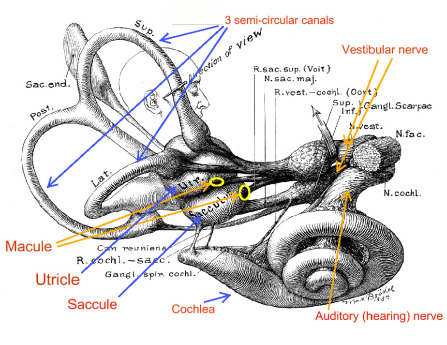
Inner Ear (illustration ©Max Brodel 1934)
To suggest that a person’s physiological reaction to wind turbine noise depends on whether she likes or dislikes wind turbines, is cruel and callous and irresponsible—and Cheryl rubs Noble’s face in it. Indeed, you will see when you watch the Helen Fraser video, below, that there are people experiencing these symptoms who started out with a very positive view of wind turbines in their midst.
“All along,” continues Cheryl, “I have been told how ‘worth it’ this was going to be, how unobtrusive they would be, how they wouldn’t really affect me much. Now I am being asked, Didn’t I know this was going to happen? Wasn’t I shown maps? Why didn’t I speak up sooner? By the time I ever heard anything about Noble coming to town, Ron Hoy, Cory Lucia and Terry Boyea had already been signed up. What could I have done? I did not sign anything until Terry was going to lose a turbine. Prior to that, I refused all agreements with Noble.”
This last point is interesting: how Noble went about signing up property owners. From reading Cheryl’s letter, it appears to have been surreptitious at first. By the time she got wind of wind energy (and Noble), apparently several of her neighbors were already signed up. “What could I have done,” she asks? I call it the Domino Effect. “Prior to that, I refused all agreements with Noble.”
The Domino Effect: You’re gonna have to live with these damn turbines on your neighbor’s property, anyway. Noise, shadow flicker, having them degrade your view and disembowel your property value. So you, too, might as well host one or two. At least this way you get some cash out of the deal. An ingenious, yet devious, strategy used by wind developers everywhere to win the hearts and minds of property owners.
Bob, how “honest and straightforward”—transparent and decent—was Noble with residents? Cheryl’s letter suggests the answer to this is, “not very.”
“The wind park has completely ruined the quality of my life in this home that I love.” With this she ends her 1/14/09 letter.
Evidently the letter had little impact on the cheery young men and women occupying the cheap trailers on Lost Nation Road. (I love the ironic gloss this name has acquired. Lost Nation Road indeed.)
A week and a half later (1/26/09), Cheryl fired off another desperate plea. This one likewise addressed to Lisa Vigneault, Dan Boyd, and two other Noble employees. “You all need to come here and experience this,” it begins. “Dots and elevation lines on a piece of paper mean NOTHING.”
I have just stood in my kitchen recording the flicker (8:15 am January 24, 2009). My head and body are trembling, dizzy, vibrating; the right way to describe what is happening to me right now eludes me. I do know that it is very uncomfortable. This feeling is from standing in my kitchen and subjecting myself to the flicker for about six minutes in order to document what has happened to my home. This is unbearable. I can not even imagine what I am going to do this summer if I am not able to buy another home.
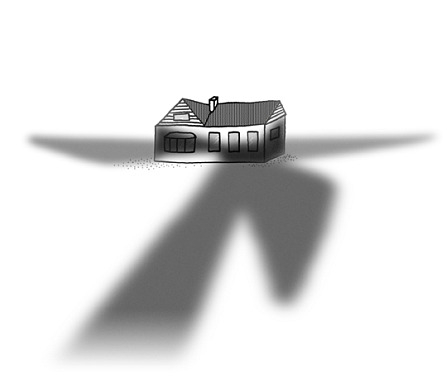
R. Forrest Martin, with appreciation
She goes on to compare her home to an “airport runway (lights), an airplane hovering overhead steadily, or an under-maintained amusement park ride (sounds), and a discotheque (flicker).”

R. Forrest Martin, with appreciation
“I am emotionally and physically sick and distraught over this. I am not in a very good position to purchase another home as my job is done on Friday.” What has the wind park done to the value her my home, she asks? “In my eyes,” she responds, “it has erased ten years of blood, sweat, tears and considerable money and hard work.”
Jeez, Bob, didn’t Noble tell us all along that living in a “wind park” (love that name!) had absolutely no negative impact on property values? I could almost swear I read that in some of Denise’s articles, and Shelly’s (Telegram), too. And I know I heard it at public meetings. All the wind developers swear absolutely this is so. (Derek, are you still reading this?) They produce documents to prove it. Reams of paper with lots of blah blah blah and tables, proving it.
Alas, Cheryl doesn’t believe them. Nor do I.
Referring to a conversation she evidently had with Lisa Vigneault, Cheryl continues, “I don’t think it fair of anyone to think I should shut up and accept what happened here just because I was an employee for a relatively short time or because somewhere in thousands of pages the town was warned.” Awnings and drapes won’t fix it, she fires back.
“TV reception? I have already purchased my Digital Converter boxes. They didn’t help. What are we waiting for on that? I am at my wits’ end. I need solid answers from you, not Lisa [Vigneault] calling and quoting what is in the town laws, studies from other areas, statements in the DEIS and FEIS, etc. I am a real person with a REAL problem. I am asking very seriously for solutions, not rhetoric and quotes. Again, I invite any and all to come experience this firsthand….Come see and hear what I do. I’m quite sure that no one could HONESTLY say there is nothing wrong with what happened here.”
Bob, still reading this? Derek, you too? Again, revisit Diaries & Reports on Dr. Pierpont’s website, and appreciate the fact this is happening virtually everywhere wind turbines are installed too close to people’s homes. Cheryl’s story is not unique. This is an industrial plague. (Derek, where’s the legal oversight on this?)
She continues:
I suggested to Tim McNeil that Noble Operations buy the house. It would be a perfect site for an Ops building for the Altona Park. Tim remarked that it is in the middle of nowhere, why would they want it? Well, maybe because it is in the MIDDLE of the damn park.
“I also think that any future development team should be aware of and see the ramifications before this happens to someone else.” God bless Cheryl LeClair: she has ethics! Why doesn’t Noble promote her to CEO? Instead, they laid her off. “I have been warned not to send this email as it may impact the offer of a contract to return as a consultant or to be rehired in the future. I find that disturbing, but if it is true, so be it. I have been a good, loyal employee and have earned my keep. This is my future.”
This is the future of many people in Clinton and Franklin counties. A future of being locked up in the nightmare from hell. I grant that not everyone who lives in one of these so-called wind parks is experiencing what Cheryl describes. But that’s not the point. If a single individual suffers like this, then there’s obviously something wrong with the siting of these wind factories. The answer is a no brainer: They don’t belong anywhere near people’s homes, for pity’s sake. It’s a crap shoot figuring out who’s going to be a Cheryl LeClair and who’s not. The stakes are too high for this “Eeny Meeny Miney Mo” nonsense.
Lest someone reading this think it’s only neighbors who complain, and not leaseholders: Watch this video. The man speaking is the Town Justice for Cohocton, NY. Judge Hal Graham. He’s describing his experience with First Wind’s turbines, that started up last month. At least one of them is on his property.
[Judge] Graham said he was a strong supporter of wind energy and studied any potential noise problems extensively by observing other wind farms in the state and asking questions.
Both he and a neighbor each have a turbine on their properties, he said.
“When I signed the contract, I was assured there was no noise,” he said. “Well, people can’t sleep at night, in the winter, with the windows closed. As the wind speed increases, the noise level rises. It rattles our windows…. It’s like a jet engine going full blast.”
The noise can be heard in neighboring hamlets of Ingleside, Atlanta and North Cohocton, according to Graham and other Cohocton residents at the meeting. Other residents complained about a lack of sleep and disturbed animals.
—Mary Perham, Gatehouse News Service, reporting on Prattsburgh (NY) town meeting, 2/17/09
Judge Hal Graham, Cohocton (NY), February 17, 2009
(Click here for a radio interview with a Cohocton, NY, homeowner experiencing Wind Turbine Syndrome from turbines on his and neighbors’ land. Canisteo Valley News.com, 2/17/09. Interviewer is Kevin Doran. The man being interviewed requested anonymity, but is widely felt to be Judge Graham.)
Finally, watch this video. Helen Fraser, Ontario, Canada. Excruciating headaches, sleeplessness, tinnitus, confusion, memory problems, nocturia, body aches, heart palpitations, panic: Helen describes classic Wind Turbine Syndrome. Dismissed by her physicians, laughed at by the municipal government, ignored by the province and blown off by the wind developer, she and her husband moved away—and all their symptoms disappeared. (To play the video, first click on the triangle at the far left of the video’s navigation bar: see bottom of video. You then get a message that the video is buffering. Once the buffering is done, you can watch the video by clicking on the “speech bubble” located immediately to the right of the triangle. To pause the video, click on the icon where the triangle was.)
Helen Fraser, Shelburne (Ontario, Canada), January 2009
I almost forgot. Cheryl made a YouTube video. As of this writing, it’s still up. “Disco Kitchen,” she called it. Be sure your speakers are turned on. (I wonder how long it will remain on YouTube before it’s yanked—at someone’s urging.)
Cheryl LeClair’s “Disco Kitchen”
You’re wondering what became of Cheryl? I wonder, too. Last email I got, she was desperately hoping Noble would buy her out, ending her ordeal. (Is this what wind energy has come to? Driving people out of their homes? Even if they’re lucky enough, or make enough uproar, to be favored with a buy-out? Is this legal? Derek, are you still reading this? If it’s legal, it sure as hell is unethical and downright contemptible. I call it gangsterism.)
Before she disappeared from my radar screen, Cheryl acknowledged that she had signed what’s called a Good Neighbor Agreement. Oops! (Good Neighbor Agreement = in return for an annual payment of $1000 or $2000, you agree to accept and not publicly complain about how you’re getting screwed by the wind developer. Good Neighbor Agreements are for neighbors of wind turbines, not leaseholders. Leaseholders sign a gag clause, typically, agreeing to essentially the same terms.)
My guess? Well, you can guess what I’m thinking. Several possibilities flash to mind, none of them savory. For her sake, I hope Cheryl got bought out. Suffice it to say, Cheryl LeClair disappeared from my email inbox, even after I contacted her with, “Hey, what was the outcome?”
Cheryl Leclair is a hero. A courageous and valiant woman. She has stood up to the sleaze and chicanery (illegality?) of Big Wind. She reminds me of these lines from a Carl Sandburg poem. “The people will live on,” he begins,
The learning and blundering people will live on.
They will be tricked and sold and again sold
And go back to the nourishing earth for rootholds,
The people so peculiar in renewal and comeback,
You can’t laugh off their capacity to take it.
Cheryl LeClair: tricked and sold and again sold. But I expect she will go back to the nourishing earth for her rootholds, ‘cause she’s one strong woman. People like Cheryl: You can’t laugh off their capacity to take it. And take it. And keep taking it.

Now, Mr. Robert O’Grady (forgive me, it’s St. Patrick’s Day; the leprechauns prompt me to tweak your fine Irish name), it’s your journalistic responsibility to continue probing and dissecting Noble.
Derek Champagne, I hope you take this as a bugle call to re-start the engines of justice.
Bob, let’s wrap it up with a few lines from that past master of journalistic wit and wisdom, H.L. Mencken, whom I know you admire as much as I do.
The only way that democracy can be made bearable is by developing and cherishing a class of men sufficiently honest and disinterested to challenge the prevailing quacks. No such class has ever appeared in strength in the United States. Thus, the business of harassing the quacks devolves upon the newspapers. When they fail in their duty, which is usually, we are at the quacks’ mercy.
—H. L. Mencken, Minority Report
References
1. See, for example, Martin & Pierpont, “Wind Farm in your yard? Think about it!” Press Republican (October 18, 2004), p. A4; Anne Britton, “Nothing looks bad without details,” Malone Telegram (April 29, 2005), p. 4; Advertisement, “551 wind turbines to be installed between Brandon and Altona,” Malone Telegram (May 28, 2005), p. 5; Martin & Pierpont, “The wind factory next door,” Press Republican (November 25, 2004); Pierpont, “Response to Noble Environmental Power’s DEIS and FEIS.” This is but a sampling of Letters to the Editor (Telegram & PR), editorials (Telegram & PR), and paid ads (Telegram & PR), all pointing out hazards from disintegrating turbines and turbines catching fire. In addition, these issues were repeatedly raised at public hearings in Ellenburg, Churubusco, Altona, Chateaugay, Malone, Brandon, Beekmantown, and Burke over the past four and a half years. Consider Nina Pierpont’s widely circulated, “Health, hazard, and quality of life near wind power installations: How close is too close?” (March 2, 2005):
» Falling over
A nacelle (generator and gearbox) weighing up to 60 tons atop a 265 ft. metal tower, equipped with 135 ft. blades, is a significant hazard to people, livestock, buildings, and traffic within a radius equal to the height of the structure (400 ft) and beyond. In Germany in 2003, in high storm winds, the brakes on a wind turbine failed and the blades spun out of control. A blade struck the tower and the entire nacelle flew off the tower. The blades and other parts landed as far as 1650 ft (0.31 mile) from the base of the tower.1 (Note that all turbines discussed in this article are “upwind,” three-bladed, industrial-sized turbines. “Downwind” turbines have not been built since the 1980’s.) Given the date, this turbine was probably smaller than the ones proposed for current construction, and thus could not throw pieces as far. This distance is nearly identical to calculations of ice throw from turbines with 100 ft blades rotating 20 times per minute (1680 ft).2
» Fires
Most fires in wind turbines are started by lightning and fueled by up to 200 gallons of hydraulic oil in the nacelle. Fire-fighting at 265 ft (26 stories) may not be possible with the equipment of a rural town. A fire may leave wind turbine controls malfunctioning until the equipment in the nacelle is repaired or replaced, making it more susceptible to the kind of accident described above.
» Setback
Based on these health effects and hazards, turbines should not be placed within 1700 feet of any road or dwelling. Those living within ½ mile (2640 ft) should be apprised that they are likely to experience very bothersome levels of noise and flicker, which continue (though to a lesser degree) to a mile or more from the turbines. At 2 miles, noise is sometimes heard, but few people are bothered. In Lincoln Township, WI, after two years with the turbines, 73% of people said they would not consider buying or building a house within a mile of the turbines, and 23% wished to be at least 2 miles away (212 people sampled).
It is significant that each of these setbacks (the first for hazard of falling objects, the second for noise) is supported by two unrelated pieces of data yielding the same result. For noise, the data from two wind installations of different ages in different countries, one by resident survey and the other an engineer’s measurements, yield the same distance at which noise stops being bothersome: at something greater than 1-1.2 miles. Thus the age or specific type of equipment is not relevant to the noise issue, and specific measurements, properly done, support what neighbors of wind installations are saying.
In conclusion, based on these data, wind turbines should not be built within 1.5 miles of people’s homes. Let it be understood, however, that there will still be health and life quality problems caused by wind turbines beyond this radius. People living 1.5 to 3 miles from a proposed turbine site should be notified of potential health and life quality effects, and for this they should be appropriately compensated.

